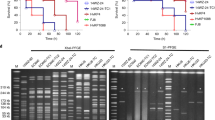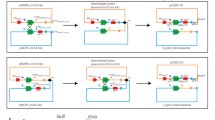Summary
In conjugational crosses, threeKlebsiella pneumoniae strains and oneSerratia marcescens strain have been demonstrated to transfer resistance determinants to newer types of cephalosporins. WhileKlebsiella strains donated cefotaxime, cefamandole and cefuroxime resistance toEscherichia coli K-12 recipients, the genetic analysis of exconjugants after the transfer of plasmids fromSerratia strains toProteus orSalmonella recipients showed that the cefoxitin resistance determinant was also co-transferred. In subsequent transfer cycles of this plasmid, cefotaxime and cefoxitin resistance determinants segregated in contrast to the relative stability of plasmids derived fromKlebsiella strains in subsequent transfer cycles. From results obtained in this study, it may be concluded that in some strains of nosocomialEnterobacteriaceae, resistance to newer cephalosporins could be transmissible and thus plasmid-located.
Zusammenfassung
Bei drei Stämmen vonKlebsiella pneumoniae und einem Stamm vonSerratia marcescens konnte demonstriert werden, daß sie bei Kreuzkonjugation Resistenzdeterminanten gegen neuere Cephalosporine übertragen. WährendKlebsiella-Stämme Resistenz gegen Cefotaxim, Cefamandol und Cefuroxim aufEscherichia coli K-12-Empfängerstämme übertrugen, zeigte die genetische Analyse der Exkonjuganten nach Übertragung von Plasmiden vonSerratia-Stämmen aufProteus- oderSalmonella-Empfängerstämme, daß die Determinante für Cefoxitin-resistenz ebenfalls mit übertragen wurde. Bei weiteren Übertragungszyklen mit diesem Plasmid spalteten sich die Determinanten für Resistenz gegen Cefotaxim und Cefoxitin ab; im Gegensatz dazu besaßen Plasmide vonKlebsiella-Stämmen in weiteren Übertragungszyklen eine relativ hohe Stabilität. Aus den Ergebnissen dieser Studie kann geschlossen werden, daß bei manchen Stämmen von nosokomialenEnterobacteriaceae Resistenz gegen neuere Cephalosporine übertragbar und folglich auf Plasmiden lokalisiert sein könnte.
Similar content being viewed by others
Literature
Then, R. L., Anghern, P. Trapping of non-hydrolysable cephalosporins by cephalosporinases inE. cloacae andP. aeruginosa. Antimicrob. Agents Chemother. 21 (1982) 711–718.
Sanders, C. C. Novel resistance selected by the new expanded-spectrum cephalosporins, a concern. J. Infect. Dis. 147 (1983) 585–589.
Krcmery, C., Antal, M., Zikmundová, V., Knothe, H.: Cefotaxime inhibits cephaloridine and azlocillin decomposition byEnterobacteriaceae. Zbl. Bacteriol. Hyg. I. Abt. Orig. I. (in print).
Author information
Authors and Affiliations
Additional information
This manuscript is dedicated to Prof.Walter Siegenthaler on the occasion of his 60th birthday.
We received notification of this paper for Prof.Siegenthaler's birthday some months ago.
Rights and permissions
About this article
Cite this article
Knothe, H., Shah, P., Krcmery, V. et al. Transferable resistance to cefotaxime, cefoxitin, cefamandole and cefuroxime in clinical isolates of Klebsiella pneumoniae and Serratia marcescens. Infection 11, 315–317 (1983). https://doi.org/10.1007/BF01641355
Received:
Accepted:
Issue Date:
DOI: https://doi.org/10.1007/BF01641355




